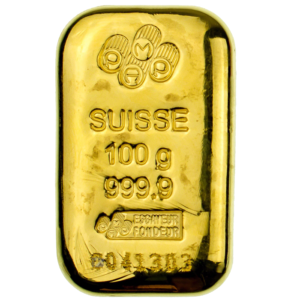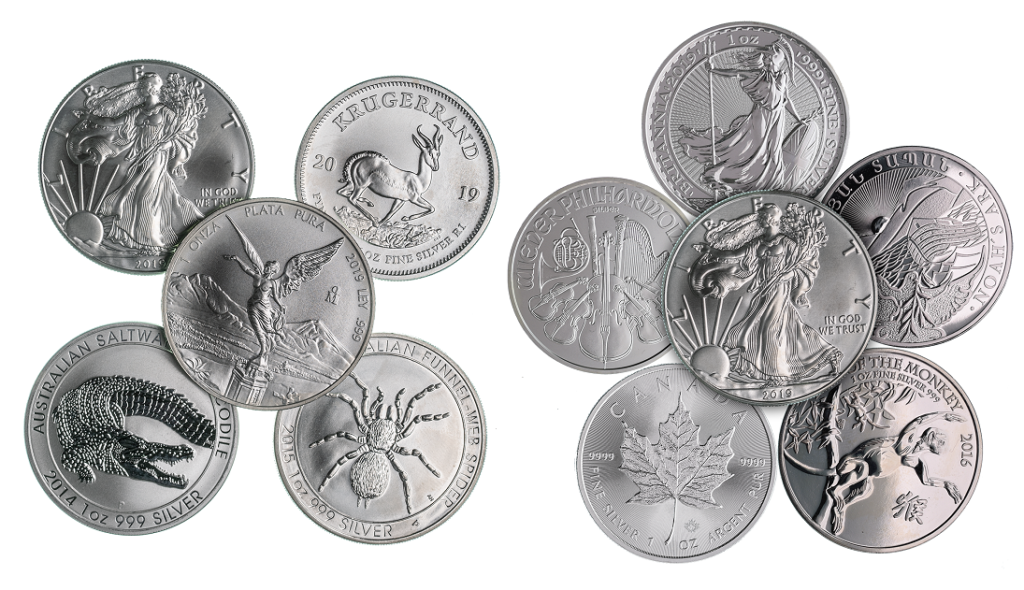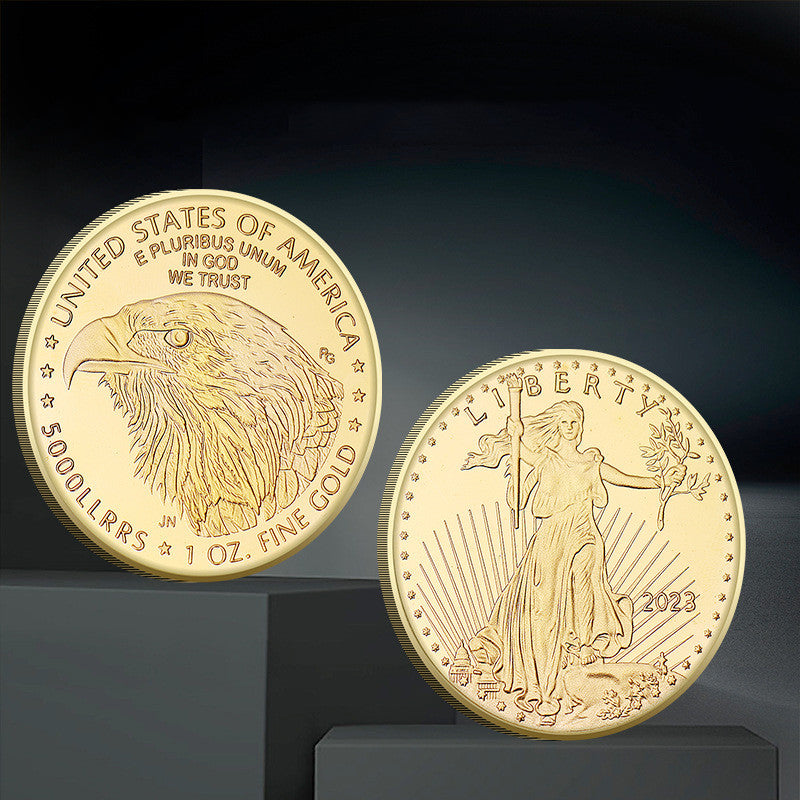Gold and silver bullion are the world’s best-known and most widely held precious metals, and both metals have played key roles throughout recorded history as forms of money, as forms of saving, and as means of wealth protection.
Today, physical gold and physical silver in the form of investment bars and investment coins are highly regarded by savers and investors as stores of values, as safe-haven assets in times of financial crises, and as practical ways of diversifying investment portfolios.
Gold and silver are proven stores of value because they retain their purchasing power over time and protect against inflation and increases in the general price level. When you buy gold and buy silver, you are protecting your purchasing power from being eroded by inflation.
Gold and silver are also proven safe-haven assets, and in times of financial market crises, investors flock to the safety of the two metals because gold and silver are free of counterparty risk. Since gold prices and silver prices move in different ways to the prices of assets such as stocks and bonds, diversifying your portfolio of investment assets to include holdings of physical gold and silver can also lower the overall risk of your portfolio.

Traditionally, gold and silver emerged as circulating money across the world’s civilisations precisely because these two metals were the best suited assets to performing the roles of money and of wealth preservation. To be widely and consistently adopted and used as money, a form of money has to be durable, easily divisible into similar units, be difficult to counterfeit, be portable, and have a limited supply. The best forms of money also have intrinsic value. Gold and silver coinages emerged and became trusted and generally accepted in economic transactions for the very fact that they met all of these requirements of being money.
Gold and Silver – The Natural Choice for Real Money
Gold and silver are tangible assets which occur naturally in deposits on and near the earth’s surface but in such limited quantities as to ensure a scarcity value. Both metals are difficult and costly to mine and have metallic characteristics making them demanded for various industrial and jewellery purposes. They hence have an intrinsic value. Both gold and silver are unreactive chemical elements, they are durable and stable, and with a low enough melting point to be easily fabricated into coins and bars. Gold and silver coins and bars are issued in known weights and metal purities and so are fungible (i.e. substitutable), and importantly, gold and silver are difficult to counterfeit and cannot be created or destroyed.

Thus, over time, gold and silver evolved as the only accepted forms of money in the provisions of the three main functions of money which are:
– A Medium of Exchange
– A Store of Value
– A Unit of Account
As societies and monetary systems became more sophisticated, gold and silver were used as the backing or foundations of many countries’ money supplies, i.e. the gold standards and silver standards of the nineteenth and twentieth centuries. In fact, gold was the anchor to the entire global monetary system between 1944 and 1971 in the Bretton Woods monetary era.
It’s interesting to note that both gold and silver have been used as money from as far back as 600 B.C., so both metals have far longer track records as money than any unbacked paper currency. This means, for example, that gold has been accepted and used as money for 2,500 years, with unbacked paper money in the form of fiat currencies only on the scene for a mere blip of time.
You own the Metal – There is no Counterparty Risk
Unlike many other investment assets such as bonds and stocks, when you own and hold physical gold and physical silver there is no counterparty risk. This is because there is no counterparty. Contrast this to a government or corporate bond where the issuer is your counterparty. Likewise, there is no default risk with gold and silver, because with physical gold and silver there is no issuing entity which could go bankrupt or that can default.

Investment gold and silver are tangible assets produced from mining and refining that exist in limited supply. They are not brought into existence by monetary authorities, governments or central banks, and gold and silver are not subject to political interference or dilution to their supplies.
On the other hand, fiat currencies such as the US dollar and Euro are subject to dilution of supply and political interference, all of which erodes their purchasing power. Fundamentally, fiat or paper currencies do not have any intrinsic value and ultimately the value of all paper currencies returns to zero. For example, since 1913, the US dollar has lost around 98-99% of its purchasing power, while during the same time gold has kept its purchasing power.
Central banks know very well that fiat currencies have no inherent value, which is precisely why central banks hold large quantities of gold bars and gold coins as part of their reserve assets, to diversify from the fiat currencies they hold, as well as to hold a store of value which is not eroded over time by inflation, and to provide emergency funding in the event of financial market crises.

Unique and Varied Demand and Supply
As tangible precious metals, both gold and silver also have many and varied uses and therefore varied demand sources which support their prices. Apart from investment demand for gold bars and gold coins, gold demand comes from Exchange Traded Funds (ETFs), central bank gold demand, the global gold jewellery sector and gold demand from industry.
Likewise, silver demand comprises investment demand for silver bars and coins, demand for silver from the jewellery and silverware sectors, and silver demand from industrial sectors (such as electronics and the photographic industry).
On the supply side, gold and silver supply comes from mine production and precious metals recycling, but supply also comes from the existing above ground stocks that are held in each metal. These above ground stocks mean that gold and silver supplies only grow slowly over time in comparison to the total amounts in existence. Looking at gold, the total amount of gold mined throughout history is about 192,000 tonnes and nearly all of this gold is still in existence in above ground stocks in the form of gold jewellery, central bank gold holdings, private sector investment gold holdings, and gold found in industrial and technological applications.
Gold mining only adds about 3,200 tonnes of new gold to these above ground gold stocks each year. Therefore the stock of gold already held in the world relative to the new annual flow of gold from mining is about 60 to 1. This gives a very stable stock to flow ratio and helps explain how gold acts as a store of value, a safe-haven, an inflation hedge and why gold and silver prices react less to economic cycles than do other assets.
Store of Value and Wealth Preservation
Physical gold and silver are proven stores of value which retain their purchasing power over time. For example, over the long term, an ounce of gold will buy roughly the same amount of goods that it did in the past despite the prices of those goods increasing, i.e. despite inflation. This is why physical gold is called an inflation hedge. Gold is able to retain its purchasing power because the entire value of the above ground stocks of gold (signaled by the gold price) adjust upwards to changes in the overall price level. Compare this to paper currencies which continually lose value over time and whose value is eroded by inflation until they hyperinflate and become practically worthless. Fiat paper currencies are not a store of value. In fact, quite the opposite.

Trusted Safe-Havens
Silver and gold are well known safe-haven assets in which investors take refuge during periods of heightened market stress and financial panics. Some of this is down to historical experience since the prices of gold and silver usually will rise during these periods of panic. But more fundamentally, people move money into gold and silver during market crises because physical precious metals don’t have any counterparty or default risks, a critical concern during market turmoil.
More fundamentally, gold and silver bars and coins are also safe haven assets during economic crises and war and conflict situations, since people can convert their wealth into precious metals and move it across borders and also resell it easily due to gold and silver’s high liquidity and recognition worldwide, and the existence of gold and silver markets in practically all countries.
Risk Reduction and Diversification
Adding an allocation of gold and silver to an investment portfolio of other assets such as stocks and bonds can also provide diversification benefits to the overall portfolio since it reduces portfolio risk and boosts portfolio returns. This is so because the prices of gold and silver are not highly correlated with the prices of other assets, which can be explained by the fact that gold and silver prices are less effected by economic cycles than stocks and bonds.
There is also a benefit from diversifying across both gold and silver. Since the demand patterns for gold and silver are different to each other, the prices of gold and silver although they mostly move in the same direction, do not move in tandem, and so you will benefit from diversification if you save or invest in both precious metals.
Bullion Bars and Bullion Coins
When saving and investing in gold and silver, it’s important to remember that some forms of gold and silver investing such as gold-backed ETFs and paper gold products only provide exposure to the prices of gold or silver but do not provide ownership of precious metals.
Only when you purchase bullion bars and bullion coins do you own real precious metals of known weights and purities, and your savings are in forms of real money which are not fiat currencies. You are the legal owner of those bars and coins, either in your possession or in vault storage with a secure storage custodian. In times of crisis or financial market panic, you have real precious metals, not just a claim to a unit of an ETF or an exposure to a synthetic paper product.

The optimal way to save and invest in physical gold and silver is in the form of high purity investment grade gold bars and gold coins and silver bars and silver coins produced by the world’s leading precious metals refineries and mints. These include national mints such as the Royal Canadian Mint, the US Mint and the Perth Mint, and the large precious refineries of PAMP, Argor-Heraeus, Valcambi and Heraeus. Bullion bars are fabricated in both minted and cast finishes and are of a specific weight and metal purity. High purity bullion coins are minted in a variety of weights, the most common being the 1 troy ounce weight. A key advantage of bullion bars and coins from well-known mints and refineries is that they are easy to sell in the future if need be as they are trusted and recognised the world over.
Conclusion
It’s notable that central banks hold real gold and not paper claims because only physical gold is a form of financial insurance against financial crises and a store of value not eroded over time by inflation. Central banks take great care in storing their gold in highly secure vaults, often in gold trading centres such as London and New York where they can trade it if need be.

There are many reasons to buy gold and silver. Chief among them are that precious metals provide you with a way to save in tangible assets which retain their purchasing power over time, that are outside the financial system, that have no counterparty risk, and that are tried and tested forms of wealth preservation and financial insurance. Physical gold and silver are highly liquid assets, known and trusted throughout the whole world. Gold and silver have proven track records over thousands of years in protecting against inflation.
When holding physical gold and physical silver in the form of high purity gold bars, silver bars, gold coins and silver coins, you are holding financial insurance in the form of assets that are ring-fenced from the financial system. And as long as you hold your precious metals outside the banking system, you will avoid the risks of financial repression so prevalent in today’s worldwide financial markets.







